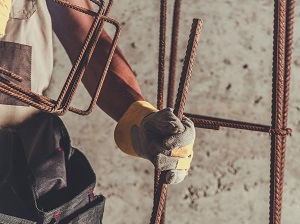Steel reinforcing bars, commonly known as rebar, are found on a majority of construction sites, and pose a variety of job site hazards that can result in injury, including:
- Cuts, Abrasions, Lacerations and Pinches
- Slips, Trips and Falls
- Strains and Back Injuries
- Puncture and Impalement

Wearing the proper work clothes and PPE is an important component of construction site safety. Always wear gloves and eye protection when handling and tying rebar. Wear additional PPE as required, which may include a hard hat, high-visibility safety vest, hearing protection and work boots. Tuck in shoelaces and pant legs to prevent hang-ups when walking through flatwork.
Typical hazards that construction workers need to be aware of because of the increased potential for injury include:
- concrete formwork pins protruding at low levels
- concrete footing rebar extending onto walking areas
- rebar sticking out from concrete foundation work
- scraps of rebar left lying around the job site
All workers should be able to recognize when rebar becomes a hazard. Housekeeping is important! Pick up scrap rebar to prevent trip hazards.
OSHA Standard 1926.25(a) During the course of construction, alteration, or repairs, form and scrap lumber with protruding nails, and all other debris, shall be kept cleared from work areas, passageways, and stairs, in and around buildings or other structures.
Limit access to the work area where formwork, protruding rebar, and rebar cages are present. For rebar that presents an impalement hazard, sufficient guarding must be in place.
Place mushroom caps on rebar to prevent cuts, abrasions, and other minor injuries when working at grade and there is no impalement hazard. Plastic mushroom caps that are not reinforced with steel are not adequate enough to protect against impalement.
The most important OSHA standard that specifically applies to rebar states:
OSHA Standard 1926.701(b) All protruding reinforcing steel, onto and into which employees could fall, shall be guarded to eliminate the hazard of impalement.
OSHA receives quite a few questions regarding this standard and all attempts to clarify it provide direction directly back to the standard itself.
If any worker could be impaled if they were to accidentally fall into or onto the rebar, then the rebar must have protection on it that would prevent the worker from being impaled by the rebar. There are no specifics regarding height, location, or direction of the rebar because every work site is different. Quite simply, rebar of any length and any diameter must be guarded when there is the hazard that a worker could fall onto the bar and be impaled (skin pierced).
OSHA states that protective devices capable of withstanding at least 250 pounds dropped from a height of ten feet will eliminate the hazard of impalement in most cases. However, as long as a protective device guards protruding rebar enough to eliminate the hazard of impalement, it satisfies the requirements of the standard.
When employees are working at any height above exposed rebar, fall protection and/or fall prevention needs to be in place. Common ways to guard rebar to prevent impalement:
- Steel-Reinforced Rebar Caps
- Carnie Caps
- Wooden Troughs
- Bending Rebar
To prevent injuries on the construction site when working with rebar, review these safety precautions:
Unload rebar from trailers as close as possible to the work area. Use proper lifting techniques and do not carry more than you can handle. Use padding to protect your shoulder and skin when carrying rebar. Observe careful hand placement to avoid pinch points, ends of tie wire and sharp edges on rebar. Wear heavy-duty gloves.
Use clear communication when working in teams. Maintain good housekeeping and clean the work area throughout the day. Take regular breaks to avoid fatigue from constant lifting.
Ensure all floor holes are covered or protected. Use fall protection when working over 6 feet. Guard all protruding rebar, onto which a worker could fall, to eliminate the hazard of impalement.

.jpg)
